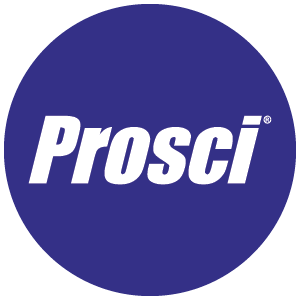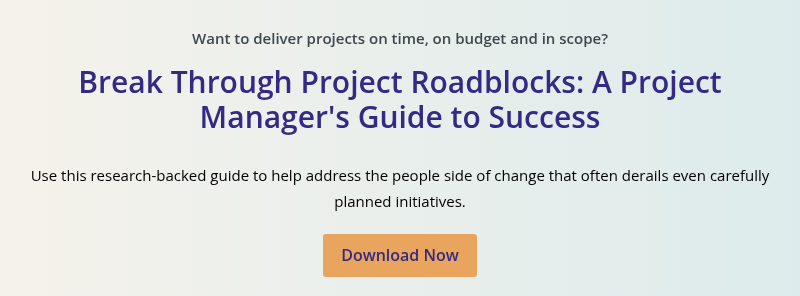What is PRINCE2 Change Management?

5 Mins
Published: June 5, 2025

PRINCE2® is one of the world’s most trusted project management methodologies because it’s structured, scalable, and built to deliver. It defines roles, guides each stage, and ensures teams stay in control from kickoff to close. But here’s the truth: delivering a project isn’t the same as delivering results.
To realize the full value of any change, organizations must go beyond implementation and use organizational change management (OCM) to focus on adoption and usage.
PRINCE2 7 acknowledges this need by aligning project delivery with people-centered approaches to change. When paired with structured OCM methods like Prosci’s ADKAR® Model, PRINCE2 helps organizations embed solutions by empowering people to thrive in the new way of working.
What is PRINCE2 Change Management?
In PRINCE2, "change management" refers to managing technical changes through a five-step Issue and Change Control process: Capture, Examine, Propose, Decide, and Implement. This process often begins with a formal request for change submitted when a deviation or enhancement is identified. It’s a disciplined way to evaluate changes, manage risk, and stay aligned with project goals, but it’s not organizational change management.
While PRINCE2 governs the solution’s delivery, organizational change management focuses on the people who need to adopt that solution. OCM is the structured approach to preparing, equipping, and supporting individuals to embrace change in their daily work.
That’s why integrating PRINCE2 with OCM is essential. Prosci’s Unified Value Proposition illustrates this clearly: project management and change management are distinct but complementary disciplines that are focused on achieving results and delivering lasting value. The technical side delivers the solution, while the people side ensures it’s used.
Prosci's Unified Value Proposition

When these two approaches work together from the start, organizations can align activities, reduce resistance, improve information flow, and ultimately increase the likelihood of project success. In fact, Prosci research shows that organizations that integrate change management and project management are 17% more likely to meet or exceed their objectives.
What is the New ‘Change Management Approach’ in PRINCE2 7?
In PRINCE2 7, the Change Management Approach has been formalized in the project initiation documentation. It is meant to help project teams handle the inevitable twists and turns that come with technical delivery.
Whether it’s a feature request, off-spec, or something unexpected, this approach lays out how the team will identify, assess, authorize, and implement the change control procedure. It brings consistency, transparency, and accountability to the process so teams can adapt quickly without losing control.
PRINCE2 7 embraces structured flexibility. It empowers teams to pivot when needed, while maintaining governance and alignment with business goals so you can manage the process with intent.
Key Processes in PRINCE2 Change Management
PRINCE2 follows a step-by-step approach that supports the project's overall goals, minimizes risk, and aligns with the business case. Here are the core processes that make up this change management cycle:
Recognize the Need for Change – Change can arise from many sources and the first step is to formally recognize when something isn’t aligned with the original plan.
Analyzing Potential Impacts – Once the issue is recognized, it’s categorized as a request for change, off-specification, or general concern. From there, the project team documents it, determines its severity, and decides whether it must follow a formal or informal resolution path.
Conduct Risk Assessments – Each change must be evaluated against the core project variables that include time, cost, scope, quality, risk, and benefits.
Align with Business Case Objectives – Will the change introduce new vulnerabilities? Increase project complexity? Delay delivery? Risk assessments help decision-makers understand potential trade-offs and plan mitigation strategies.
Approval & Authorization – A cornerstone of PRINCE2 is its emphasis on continued business justification. Changes must be measured against the project’s original intent and benefits. If a change compromises the business case or doesn’t support the intended value, it should not move forward. These decisions often involve the project board and the designated change authority.
Implementation & Review of Changes and Outcomes – Apply changes in a controlled way and confirm outcomes delivered their intended value without negatively affecting other areas of the project. Any follow-up actions or unresolved items should be tracked in the issue register for accountability.

Benefits of Integrating Effective Organizational Change Management with PRINCE2 Project Management
Pairing PRINCE2’s structured project delivery OCM is a proven way to improve outcomes. While PRINCE2 ensures that the technical solution is built and delivered correctly, OCM ensures that people adopt and use that solution. Combined they deliver:
Better Results Across the Board – The most compelling reason to integrate OCM with PRINCE2? It improves results. Prosci research shows that with excellent change management, projects are:
- 7x more likely to meet objectives
- Nearly 5x more likely to stay on or ahead of schedule
- 1.5x more likely to stay on or under budget
These gains stem from higher adoption and usage, faster ramp-up times, and fewer costly delays due to confusion or resistance.
Structured Governance – Integrating OCM with PRINCE2 aligns change leadership, project teams, and impacted employees under one shared goal, supported by clearly defined roles and milestones.
Accountability and Transparency – With aligned workflows, both project managers and change leaders can better support each stakeholder by tracking what’s being delivered, how it’s being adopted, and where support is needed.
Risk Mitigation – Poorly managed change leads to delays, rework, and even failure. Effective OCM identifies resistance before it becomes a blocker and builds strategies to manage it proactively.
Proactive Disruption Management – Change is disruptive by nature and OCM enables organizations to plan for change thoughtfully: engaging sponsors, preparing managers, and supporting employees to maintain momentum even as roles, routines, or tools evolve.
Higher Employee Engagement – When change is done with people (and not to them), engagement rises, driving faster adoption and longer-lasting results.
Organizational Change Management With PRINCE2
PRINCE2 provides the structure to deliver a solution. Organizational change management (OCM) helps people adopt and use it. At the heart of this people-centered approach is the Prosci ADKAR® Model, a practical tool for enabling individual change that scales to fit projects of any size or complexity.
Developed by Prosci founder Jeff Hiatt, the ADKAR Model defines five outcomes every individual must achieve for change to be successful: Awareness, Desire, Knowledge, Ability, and Reinforcement. These outcomes map to the emotional and cognitive journey people take when faced with change.
While PRINCE2 manages the technical delivery of a project, ADKAR guides how individuals come to understand, embrace, and sustain new ways of working. And because organizational change only happens when individuals change, aligning these two approaches creates a complete strategy for success.
Prosci ADKAR Model

Aligning ADKAR With PRINCE2 Project Management
In traditional sequential (Waterfall) project environments, you can map ADKAR milestones directly to key project phases. For example:
- Awareness and Desire should be addressed early in project initiation and planning
- Knowledge and Ability align with training and go-live milestones
- Reinforcement is built into sustainment efforts post-deployment
For iterative or Agile environments, the ADKAR Model is applied in cycles:
- Awareness and Desire must be established at the initiative level and revisited with each sprint or release
- Knowledge and Ability align with each release’s training and support activities
- Reinforcement happens continuously, following each release, helping teams sustain momentum over time
Most organizations use a hybrid approach, blending sequential and iterative elements. The ADKAR Model adapts easily to both. It’s flexible enough to match the pace of innovation while still providing the structure needed to guide people through change.
Scaling ADKAR for Organizational Change
While ADKAR focuses on individual outcomes, Prosci’s 3-Phase Process scales those outcomes across teams, departments, and entire enterprises. It provides a repeatable framework for applying ADKAR at the organizational level:
- Phase 1: Prepare Approach – Define success, assess change characteristics, and build strategy
- Phase 2: Manage Change – Create and execute plans for communication, sponsorship, training, coaching, and resistance management
- Phase 3: Sustain Outcomes – Measure adoption, reinforce change, and celebrate success
Used together, PRINCE2 and OCM form a complete approach—a structure for delivery and support for the people making it real.
3-Phase Process

Delivering Change That Lasts
PRINCE2 builds the path. Prosci’s ADKAR Model helps people walk it. When you combine the two, you don’t just launch projects, you embed change. Whether your team is deploying a new technology, redesigning a process, or leading cultural transformation, the combination of technical precision and people-centered planning is what unlocks true success.
For teams new to this integrated approach, investing in project management training that includes organizational change management can help build the foundation for long-term success.
Want to make your next initiative count? Download The ADKAR Model for Organizational Change and learn how to lead change that delivers results.




